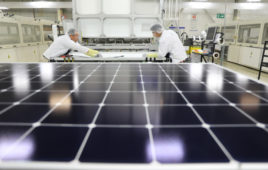
“We see a tendency toward more solar O&M being “baked into” the beginning of the construction and engineering phases of PV development in the U.S. This was true of the Origis Energy 24 MW in Georgia for which our team brought O&M considerations into the conversation very early in the development of those assets.”
— Vassilis Papaeconomou
Editor’s Note: This article by Glenna Wiseman is Part 2 of a three-part look at the importance of solar PV operations-and-maintenance. The series covers the evolving O&M market prior to the first trade event solely dedicated to this topic in the United States, Solar O&M North America later this month in San Francisco.
Glenna Wiseman is a solar marketing executive and the founder of Identity3, a marketing services company leveraging the unique marketplace identity of solar, renewable energy and green economy companies to fuel their growth. Email her at GWiseman@Identity3.com.
By Glenna Wiseman, Solar Power World Contributor
The evolution of the global solar PV industry means operations-and-maintenance (O&M) is light-years ahead in Europe. Part two of our series delves into factors shaping the differences in the U.S. and European solar PV O&M markets.
Our Experts
 Cedric Brehaut (CB), principal consultant at SoliChamba and author of the GTM Research 2013 report, “Megawatt-Scale PV Plant Operations and Maintenance: Services, Markets and Competitors, 2013-2017” Brehaut has extensive experience in the solar industry and is an expert in solar PV monitoring and O&M.
Cedric Brehaut (CB), principal consultant at SoliChamba and author of the GTM Research 2013 report, “Megawatt-Scale PV Plant Operations and Maintenance: Services, Markets and Competitors, 2013-2017” Brehaut has extensive experience in the solar industry and is an expert in solar PV monitoring and O&M.
 Christoph Neufink, who has been in the solar O&M market since 2009, is the director of service at skytron energy. Birthed in the early stages of the European PV market, skytron energy has three decades of industry experience and 4.5 GW of solar under monitoring management. The company announced its initial U.S. project in October, a 5.8 MW commercial PV install in Yuma, Ariz.
Christoph Neufink, who has been in the solar O&M market since 2009, is the director of service at skytron energy. Birthed in the early stages of the European PV market, skytron energy has three decades of industry experience and 4.5 GW of solar under monitoring management. The company announced its initial U.S. project in October, a 5.8 MW commercial PV install in Yuma, Ariz.
 Vassilis Papaeconomou brings the perspective of the independent solar O&M provider. He is the managing director of Alectris, a Greek-based independent O&M firm, now making headway in the United States. Papaeconomou’s solar experience started in 2006 on the development and construction side before moving into O&M in 2012. Alectris has nearly 100 projects under O&M management including its initial U.S. projects.
Vassilis Papaeconomou brings the perspective of the independent solar O&M provider. He is the managing director of Alectris, a Greek-based independent O&M firm, now making headway in the United States. Papaeconomou’s solar experience started in 2006 on the development and construction side before moving into O&M in 2012. Alectris has nearly 100 projects under O&M management including its initial U.S. projects.
Here are the five themes that emerged from our discussions:
1. Money Related Differences Influence Market Fundamentals
CB: The value of solar energy is overall lower in America than in Europe, and the U.S. investment tax credit (ITC) is not a production-based incentive. European feed-in tariffs, on the other hand, tend to put a higher price on every kWh produced, so they encourage adoption of production-enhancing technologies and O&M services.
The prevalence of ‘third-party ownership’ financing — like solar power purchase agreements (PPA) and leases — in the United States produces large portfolios of assets in the hands of few operators, while European markets show a fragmentation of assets across a variety of investors, large and small.
2. The Impact of Mindset on O&M
CN: In Germany, the mindset toward O&M is influenced by the cultural proclivity to “fix it before it breaks” vs. the U.S. mantra of “never fix it until it is broken.” There are disadvantages to both. Fixes to operating components taht may still have life can impact the investor’s return on investment negatively. On the other hand, fixes that wait until energy generation is affected tend to cost more in the long run.
VP has a different opinion: The O&M concept is better understood in the United States than Europe, probably because the United States is a more services agnostic market, whereas Europeans tend to undervalue services. We see already a lot of companies in America that have identified the market need for O&M services. In Europe, this process took some years.
3. Development Stage Differences Shape Current O&M Potential
CN: The United States is ramping up faster with larger plants than Europe, with smaller base of skilled professionals to handle the O&M. Developers must think about the labor force much more in advance than in Europe.
More systems are getting older and aging out of the warranty period in Europe which opens up the O&M contract to negotiation. Along with more independent O&M service companies, these factors are creating the opportunity for investors to negotiate new, lower costs but are leaving performance guarantees off the table.
VP: The United States has a larger number of large plants. This is not necessarily market specific, but more because the technology and financing tools and know-how have increased a lot. From the market development point of view, the United States is developing at a more controlled rate than Europe. We see better quality plants in the states. and a more sustainable growth of the market.The United States is also doing significantly more in terms of developing standards, and is being more innovative in bringing costs down.
4. The Solar Secondary Market: Existing Vs. Emerging
CB: Europe has a secondary market where solar PV assets are sold to new investors. This often results in renegotiation of O&M contracts and/or a switch of O&M providers. Most solar assets in America are still owned by the initial investor, although this is beginning to change.
CN: The secondary market is more alive and vibrant in Europe than in the United States. Solar parks are changing hands more frequently due to many factors, including EPC firms going under as the construction of sites slows down. When a plant changes hands the new investor/owner typically is aggregating several sites and wants to have the same O&M supplier and monitoring system for all assets to standardize reporting. We are spending a lot of time on new contracts, moving monitoring from the first third-party to the second third-party owner.
5. Differences in the O&M Services Landscape
O&M Service Providers
CB: The largest American O&M players are vertically-integrated solar firms, while in Europe leaders tend to be EPCs, and the markets are more fragmented. Independent O&M providers are growing in number and marketshare in both regions.
When O&M Services Enter the Construction Picture
VP: We see a tendency toward more solar O&M being expressly integrated into the beginning of the construction and engineering phases of PV development in the United States. This was true of the Origis Energy 24 MW in Georgia, for which our team brought O&M considerations into the conversation early in the development of those assets.
CN differs: O&M is typically at the construction table earlier in Europe. It is more often involved in the early stage of the construction of a new solar plant in Europe than the United STates. Acting as a type of quality controller, the investor or developer involves O&M early to ensure quality standards and O&M efficiency after the build.
Services Related
CN: The “fix it before it’s broken” mindset does influence the demand for monitoring granularity. In the United States, big plants barely have a monitoring system — only the meter is monitored. In the European market, much more detail is required including string monitoring on every larger installation, detailed monitoring equipment and a more comprehensive scope and depth of monitoring information.
CB: Theft and vandalism are usually not a concern in America, whereas most European markets (except Germany) require intrusion detection, video surveillance and/or on-call private security staff.
Skilled Labor Base
CN: Another example affected by both proximity and availability is the skilled labor pool. In Europe, almost every electrician has solar experience. In the next village or hamlet over, there is a skilled electrician who can at least handle the most basic of on-site solar PV O&M fixes. The continent has 15 to 20 years of solar experience with the attendant ramifications on the training of electricians to handle PV installation and repair. This is applicable across Europe except in new markets. In theUnited States. the talent to handle O&M incident management is far away geographically from most plants. Additionally when you build a plant, you train up to three levels of workers, so you have O&M service labor options.
Performance Guarantees
VP: In the States, EPC contractors and O&M providers are less willing to provide performance guarantees, whereas in Europe it is standard. Such guarantees were given without much thinking, and companies were opportunistic because of the huge margins they had in the EPC. Now many companies are distressed, so they are willing to promise more than they can do to get more contracts. The European market is becoming healthier and serious companies do not promise something they have not checked and are sure they can perform.
Want more? Try these articles:
Part 1: Solar Is NOT Maintenance Free: The Growing U.S. Solar O&M Market
Can Gender Profiling Help YOU Expand Your Solar Business?
Webinar: Don’t Settle For Dirty Panels — O&M Can Save The Day





Christoph, based on my experience and research, large plants in the US are monitoring a lot more than the meter. The grid operator or utility company may only ask for meter data, but the plant operator (and the owner) want at least inverter and weather data, and in most cases master combiner level data as well. String monitoring is rare in the U.S. but there are many reasons for this — and I believe the biggest one is that energy prices are so low here. Recently a utility-scale solar PPA was announced for a price under 5 cents per kWh. This makes the ROI difficult for a string monitoring solution. I read case studies proving the ROI of string monitoring for a 40 eurocent FIT plant, but I have yet to see such calculation pencil out for a 5 to 8 cent PPA, at least with the price levels currently observed for string monitoring solutions.